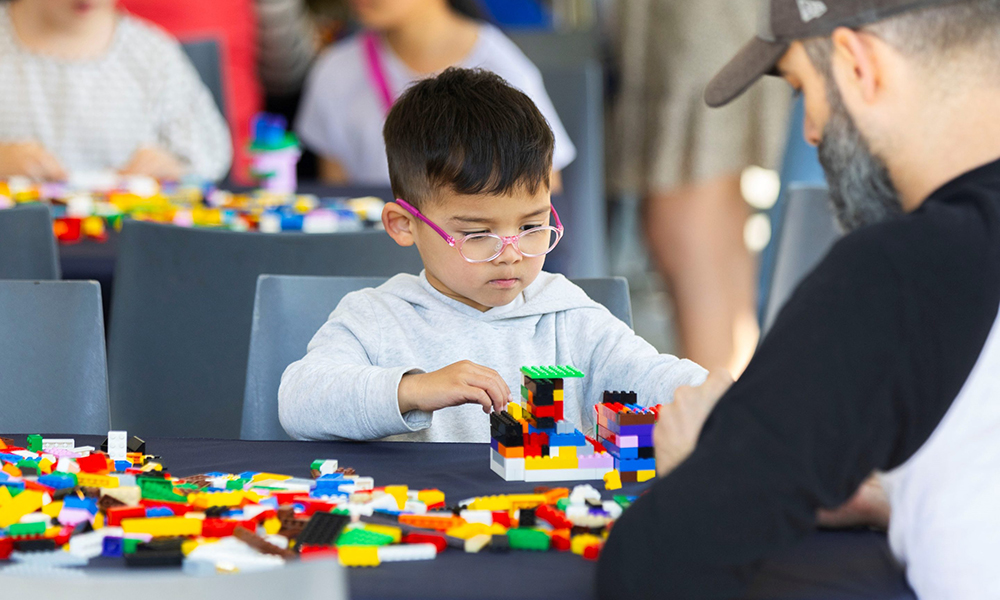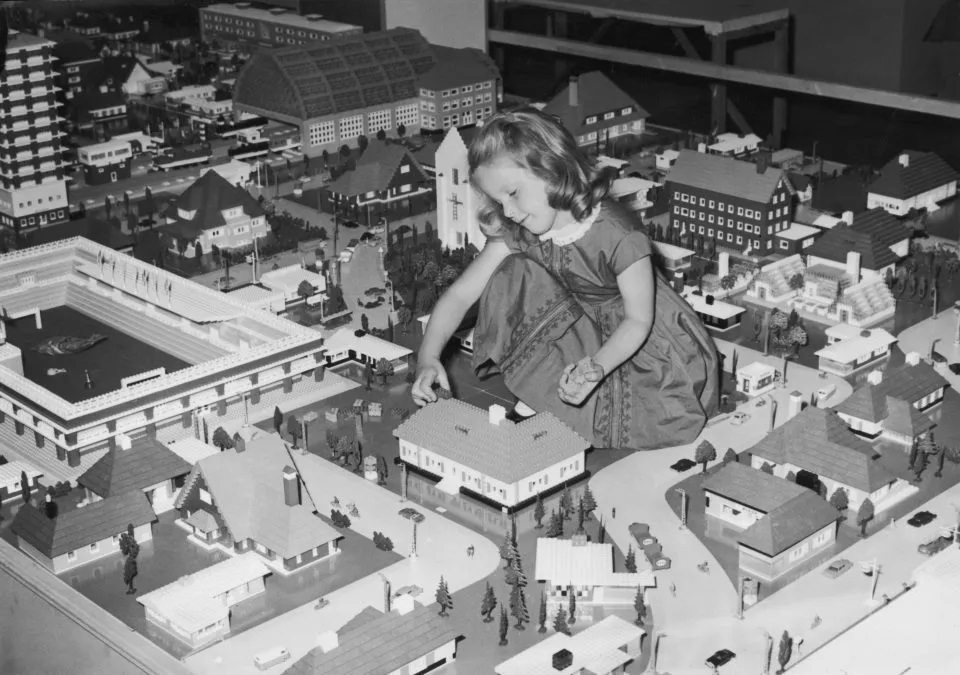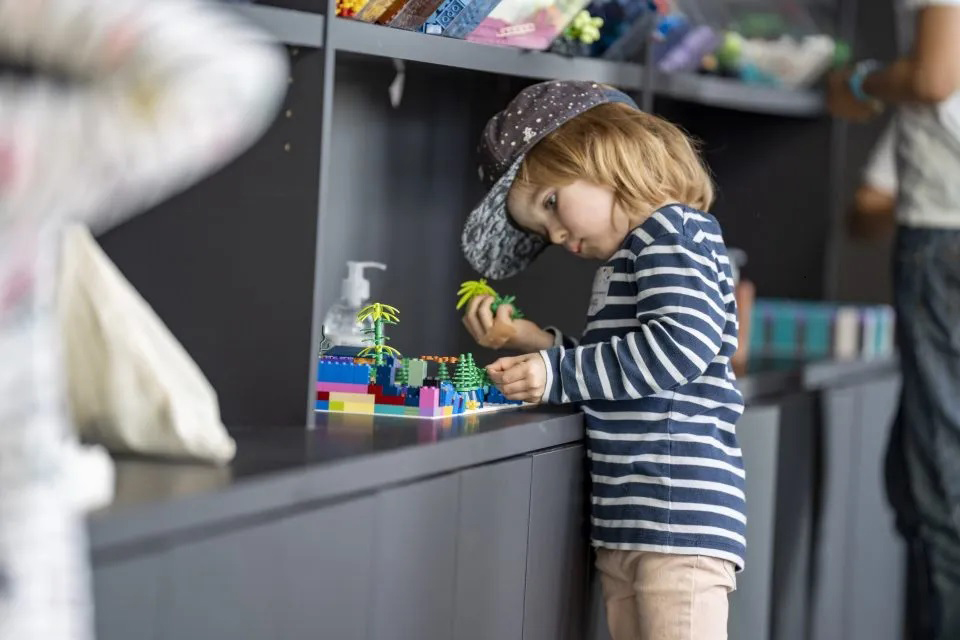
打開一套樂(lè)高玩具,,你既會(huì)不知所措,又會(huì)興奮不已,。92年來(lái),,盒子里的每個(gè)元素都有大量的積木和微小的細(xì)節(jié)構(gòu)成,用這些積木搭建城堡,、火箭飛船,、城市天際線等的渴望吸引了無(wú)數(shù)兒童。
2024年,,很少有公司能夠復(fù)制樂(lè)高的成功路徑,。樂(lè)高玩具跨越了幾代人,從與自己喜愛的玩具重新建立聯(lián)系的成年愛好者到下一代,。
1932年,,樂(lè)高玩具誕生之初只不過(guò)是一個(gè)木匠的激情項(xiàng)目,如今已成為兒童童年不可或缺的一部分,。無(wú)論是建筑,、動(dòng)漫、賽車還是爵士樂(lè),,只要說(shuō)出相關(guān)主題,,都可能有一套樂(lè)高玩具。

幾十年過(guò)去了,樂(lè)高很可能被更容易上癮、更吸引人的電子產(chǎn)品所取代,。但事實(shí)并非如此,,對(duì)于這家丹麥家族企業(yè)來(lái)說(shuō),如果情況有什么變化的話,,那就是情況再好不過(guò)了,。2023年,樂(lè)高以創(chuàng)紀(jì)錄的銷售業(yè)績(jī)超越了玩具市場(chǎng),,收入增長(zhǎng)了2%,,達(dá)到660億丹麥克朗(約合97億美元),而整個(gè)行業(yè)則下降了7%,。
那么,,樂(lè)高究竟有什么秘訣讓孩子們(以及最近的成年人)對(duì)其五顏六色的積木情有獨(dú)鐘呢?
《財(cái)富》雜志獨(dú)家探訪了樂(lè)高產(chǎn)品開發(fā)的幕后故事,,以及讓這一標(biāo)志性品牌保持活力的秘訣,。
樂(lè)高的長(zhǎng)期主題之一——太空——闡釋了它的獨(dú)特之處,也是樂(lè)高能夠經(jīng)受住時(shí)間考驗(yàn)的原因,。早在20世紀(jì)70年代,,樂(lè)高就將太空作為其開發(fā)玩具的三大官方類別之一(另外兩大類別是“城堡”和“城市”)。太空代表著未來(lái)的神秘屬性,,就像過(guò)去城堡代表的神秘屬性一樣,。多年來(lái),太空主題一直深受孩子們的喜愛,,因?yàn)樗軌蚣ぐl(fā)孩子們的想象力,,是充滿無(wú)限機(jī)遇的領(lǐng)域。
樂(lè)高首席產(chǎn)品和營(yíng)銷官朱莉婭·戈?duì)柖,。↗ulia Goldin)在接受《財(cái)富》雜志采訪時(shí)表示:“搭樂(lè)高本身就是一種激情,。”
傾聽孩子們的心聲,,為孩子們服務(wù)
樂(lè)高很早就意識(shí)到,,如果不直接聽取孩子們的意見,就無(wú)法了解他們想要什么,。戈?duì)柖≌f(shuō),,該公司大約在10年前就做出了這個(gè)深思熟慮的決定,這使得公司改變了制造玩具的方式,。
戈?duì)柖≌f(shuō):“樂(lè)高玩具的獨(dú)特之處在于,,首先要真正了解受眾。不僅僅是了解他們會(huì)對(duì)什么感興趣,,還要了解這種體驗(yàn)的正確動(dòng)態(tài)是什么,?!?
圖特告訴《財(cái)富》雜志:“當(dāng)家長(zhǎng)為孩子購(gòu)買樂(lè)高玩具時(shí),,他們認(rèn)為這能幫助孩子鍛煉大腦,。他們(樂(lè)高)試圖為所有人開發(fā)產(chǎn)品?!?/p>
將想法變成現(xiàn)實(shí)
作為一家老牌玩具制造商,,樂(lè)高已經(jīng)開發(fā)了一臺(tái)運(yùn)轉(zhuǎn)良好的機(jī)器,幫助它不斷產(chǎn)生新創(chuàng)意,。該公司每年都會(huì)舉辦一次“推廣周”活動(dòng)——可以把它想象成一個(gè)快速的頭腦風(fēng)暴會(huì)議,,通常與開發(fā)新概念的初創(chuàng)公司有關(guān)。設(shè)計(jì)師可以提出新創(chuàng)意,,或者在現(xiàn)有創(chuàng)意的基礎(chǔ)上進(jìn)行修改,,這讓他們?cè)谌粘9ぷ髦庥辛藙?chuàng)作自由。樂(lè)高公司的創(chuàng)意主管丹尼爾·米漢(Daniel Meehan)說(shuō),,雖然目標(biāo)是查看哪些創(chuàng)意可以變成潛在的樂(lè)高套裝,,但并沒有需要實(shí)現(xiàn)的清單。
下一步是確定模型的“可解碼性”,,包括找到能講故事的元素,,讓它們的參與性更高,比如樂(lè)高宇航員或可收集的紫色水晶,。
除了從公司指定的玩具開發(fā)人員那里獲得創(chuàng)意外,,公司還直接聽取受眾的意見。
米漢說(shuō):"我們還廣泛地與孩子們一起進(jìn)行游戲測(cè)試,?!?/p>
該公司將世界各地的孩子們聚集在一起,從德國(guó)到中國(guó),,了解他們更想要的玩具類型,。這個(gè)過(guò)程產(chǎn)生了我們今天在樂(lè)高太空主題套裝中看到的關(guān)鍵元素之一,米漢說(shuō)(他是該公司最近太空活動(dòng)的帶頭人),。
在其中一次太空“自己動(dòng)手測(cè)試”中,,其中一個(gè)孩子讓一輛帶輪子的飛行器飛行,沿途收集外星人——而這兩樣?xùn)|西都不在最初的設(shè)計(jì)中,。
“我們都是成年人,,非常務(wù)實(shí)......但在孩子們眼里,,這是完美的太空飛行器。但唯一的抱怨是:他(那個(gè)孩子)說(shuō)我們需要更多的外星人,。因?yàn)檫@個(gè)孩子,,我們?cè)诤凶永锓帕烁嗟耐庑侨恕,!?/p>
樂(lè)高的質(zhì)量和復(fù)雜性使其產(chǎn)品價(jià)格昂貴,,有時(shí)甚至比最新款iPhone還要貴。從市場(chǎng)上撤出的產(chǎn)品尤其如此,,這使得它們變得罕見,。其產(chǎn)品的新奇性使其成為收藏家的夢(mèng)想,在美國(guó)甚至成為價(jià)值10萬(wàn)美元的搶劫對(duì)象,。該公司表示,,它提供不同價(jià)位的套裝,所以沒有人望而止步,。該公司最簡(jiǎn)單的產(chǎn)品售價(jià)可能僅為個(gè)位數(shù),,而7500件組件的“千年鷹”套裝售價(jià)約為960美元。
對(duì)細(xì)節(jié)的熱愛
誠(chéng)然,,樂(lè)高對(duì)質(zhì)量和細(xì)節(jié)的關(guān)注并不是新現(xiàn)象,。該公司的創(chuàng)始人奧爾·科克·克里斯提安森(Ole Kirk Kristiansen)將這一理念嚴(yán)格灌輸給他的兒子。他的兒子曾試圖用兩層油漆而不是三層油漆來(lái)加快訂單制作,,結(jié)果遭到了訓(xùn)斥,。
該公司對(duì)細(xì)節(jié)的偏好不僅體現(xiàn)在其太空創(chuàng)作或玩具開發(fā)過(guò)程中,也體現(xiàn)在其業(yè)務(wù)上,。以戈?duì)柖槔?,他的?huì)議既關(guān)注公司目前的業(yè)績(jī),也討論未來(lái)幾年的發(fā)展計(jì)劃,。
作為一家玩具制造商,,這家丹麥公司的傳統(tǒng)在很大程度上與它如何讓不同年齡段、不同興趣愛好和不同經(jīng)驗(yàn)水平的人都能參與游戲有關(guān),。米漢解釋說(shuō),,太空主題可以面向三類受眾:講故事的人,,他們大多是對(duì)這一主題著迷的孩子;愛好者,,他們有興趣了解這一領(lǐng)域,;其他受眾,他們通常對(duì)太空的一切事物,,包括其藝術(shù)方面都很感興趣,。
“它們的另一個(gè)優(yōu)勢(shì)是,既能吸引幼兒,,也能用復(fù)雜的作品吸引青少年或成年人,。因此,它們與你一起成長(zhǎng),?!眻D特說(shuō),。

這種細(xì)化的方法也適用于樂(lè)高如何為產(chǎn)品和設(shè)計(jì)定價(jià),,以及如何為其新興的成人粉絲群推銷套裝,,確保每個(gè)人都能找到適合自己的玩具。但有一點(diǎn)是毋庸置疑的:無(wú)論動(dòng)機(jī)如何,,公司都盡量不淡化細(xì)節(jié),,原因是這會(huì)賦予樂(lè)高玩具個(gè)性。
戈?duì)柖≌f(shuō),,樂(lè)高迷“確實(shí)注意到了”公司添加的小元素,,因?yàn)樗鼈儭皫?lái)了更多興奮感”。
她說(shuō):"它遠(yuǎn)不止是一個(gè)玩具,,原因是這是一種身臨其境的體驗(yàn),。”(財(cái)富中文網(wǎng))
譯者:中慧言-王芳
打開一套樂(lè)高玩具,,你既會(huì)不知所措,,又會(huì)興奮不已。92年來(lái),,盒子里的每個(gè)元素都有大量的積木和微小的細(xì)節(jié)構(gòu)成,,用這些積木搭建城堡、火箭飛船,、城市天際線等的渴望吸引了無(wú)數(shù)兒童,。
2024年,很少有公司能夠復(fù)制樂(lè)高的成功路徑,。樂(lè)高玩具跨越了幾代人,,從與自己喜愛的玩具重新建立聯(lián)系的成年愛好者到下一代,。
1932年,樂(lè)高玩具誕生之初只不過(guò)是一個(gè)木匠的激情項(xiàng)目,,如今已成為兒童童年不可或缺的一部分,。無(wú)論是建筑、動(dòng)漫,、賽車還是爵士樂(lè),,只要說(shuō)出相關(guān)主題,都可能有一套樂(lè)高玩具,。
幾十年過(guò)去了,,樂(lè)高很可能被更容易上癮、更吸引人的電子產(chǎn)品所取代,。但事實(shí)并非如此,,對(duì)于這家丹麥家族企業(yè)來(lái)說(shuō),如果情況有什么變化的話,,那就是情況再好不過(guò)了,。2023年,樂(lè)高以創(chuàng)紀(jì)錄的銷售業(yè)績(jī)超越了玩具市場(chǎng),,收入增長(zhǎng)了2%,,達(dá)到660億丹麥克朗(約合97億美元),而整個(gè)行業(yè)則下降了7%,。
那么,,樂(lè)高究竟有什么秘訣讓孩子們(以及最近的成年人)對(duì)其五顏六色的積木情有獨(dú)鐘呢?
《財(cái)富》雜志獨(dú)家探訪了樂(lè)高產(chǎn)品開發(fā)的幕后故事,,以及讓這一標(biāo)志性品牌保持活力的秘訣,。
樂(lè)高的長(zhǎng)期主題之一——太空——闡釋了它的獨(dú)特之處,也是樂(lè)高能夠經(jīng)受住時(shí)間考驗(yàn)的原因,。早在20世紀(jì)70年代,,樂(lè)高就將太空作為其開發(fā)玩具的三大官方類別之一(另外兩大類別是“城堡”和“城市”)。太空代表著未來(lái)的神秘屬性,,就像過(guò)去城堡代表的神秘屬性一樣,。多年來(lái),太空主題一直深受孩子們的喜愛,,因?yàn)樗軌蚣ぐl(fā)孩子們的想象力,,是充滿無(wú)限機(jī)遇的領(lǐng)域。
樂(lè)高首席產(chǎn)品和營(yíng)銷官朱莉婭·戈?duì)柖,。↗ulia Goldin)在接受《財(cái)富》雜志采訪時(shí)表示:“搭樂(lè)高本身就是一種激情,。”
傾聽孩子們的心聲,為孩子們服務(wù)
樂(lè)高很早就意識(shí)到,,如果不直接聽取孩子們的意見,,就無(wú)法了解他們想要什么。戈?duì)柖≌f(shuō),,該公司大約在10年前就做出了這個(gè)深思熟慮的決定,,這使得公司改變了制造玩具的方式。
戈?duì)柖≌f(shuō):“樂(lè)高玩具的獨(dú)特之處在于,,首先要真正了解受眾,。不僅僅是了解他們會(huì)對(duì)什么感興趣,還要了解這種體驗(yàn)的正確動(dòng)態(tài)是什么,?!?
市場(chǎng)研究公司Circana的全球玩具行業(yè)顧問(wèn)弗雷德里克·圖特(Frédérique Tutt)表示,樂(lè)高積木的質(zhì)量是其與眾不同的另一個(gè)因素,,即樂(lè)高積木可以代代相傳,。與不需要?jiǎng)幽X筋的游戲不同,家長(zhǎng)認(rèn)為孩子們可以從樂(lè)高玩具中獲得一些好處,,無(wú)論是工程能力還是發(fā)揮創(chuàng)造力,。
圖特告訴《財(cái)富》雜志:“當(dāng)家長(zhǎng)為孩子購(gòu)買樂(lè)高玩具時(shí),他們認(rèn)為這能幫助孩子鍛煉大腦,。他們(樂(lè)高)試圖為所有人開發(fā)產(chǎn)品,?!?/p>
將想法變成現(xiàn)實(shí)
作為一家老牌玩具制造商,,樂(lè)高已經(jīng)開發(fā)了一臺(tái)運(yùn)轉(zhuǎn)良好的機(jī)器,幫助它不斷產(chǎn)生新創(chuàng)意,。該公司每年都會(huì)舉辦一次“推廣周”活動(dòng)——可以把它想象成一個(gè)快速的頭腦風(fēng)暴會(huì)議,,通常與開發(fā)新概念的初創(chuàng)公司有關(guān)。設(shè)計(jì)師可以提出新創(chuàng)意,,或者在現(xiàn)有創(chuàng)意的基礎(chǔ)上進(jìn)行修改,,這讓他們?cè)谌粘9ぷ髦庥辛藙?chuàng)作自由。樂(lè)高公司的創(chuàng)意主管丹尼爾·米漢(Daniel Meehan)說(shuō),,雖然目標(biāo)是查看哪些創(chuàng)意可以變成潛在的樂(lè)高套裝,,但并沒有需要實(shí)現(xiàn)的清單。
下一步是確定模型的“可解碼性”,,包括找到能講故事的元素,,讓它們的參與性更高,比如樂(lè)高宇航員或可收集的紫色水晶,。
除了從公司指定的玩具開發(fā)人員那里獲得創(chuàng)意外,,公司還直接聽取受眾的意見。
米漢說(shuō):"我們還廣泛地與孩子們一起進(jìn)行游戲測(cè)試,?!?/p>
該公司將世界各地的孩子們聚集在一起,,從德國(guó)到中國(guó),了解他們更想要的玩具類型,。這個(gè)過(guò)程產(chǎn)生了我們今天在樂(lè)高太空主題套裝中看到的關(guān)鍵元素之一,,米漢說(shuō)(他是該公司最近太空活動(dòng)的帶頭人)。
在其中一次太空“自己動(dòng)手測(cè)試”中,,其中一個(gè)孩子讓一輛帶輪子的飛行器飛行,,沿途收集外星人——而這兩樣?xùn)|西都不在最初的設(shè)計(jì)中。
“我們都是成年人,,非常務(wù)實(shí)......但在孩子們眼里,,這是完美的太空飛行器。但唯一的抱怨是:他(那個(gè)孩子)說(shuō)我們需要更多的外星人,。因?yàn)檫@個(gè)孩子,,我們?cè)诤凶永锓帕烁嗟耐庑侨恕,!?/p>
在樂(lè)高套裝中添加外星人,,比如在樂(lè)高空間站中,為原本簡(jiǎn)單的套裝增添了更多的層次,,同時(shí)也標(biāo)志著將其他類別的套裝聯(lián)系在一起的共同線索,。例如,在空間科學(xué)實(shí)驗(yàn)室和探月車套裝中也能找到樂(lè)高外星人,。米漢在接受《財(cái)富》雜志采訪時(shí)表示,,這些綠色的小生物被刻意設(shè)計(jì)成相似的樣子,以此來(lái)提示樂(lè)高積木的搭建者,。
樂(lè)高的質(zhì)量和復(fù)雜性使其產(chǎn)品價(jià)格昂貴,,有時(shí)甚至比最新款iPhone還要貴。從市場(chǎng)上撤出的產(chǎn)品尤其如此,,這使得它們變得罕見,。其產(chǎn)品的新奇性使其成為收藏家的夢(mèng)想,在美國(guó)甚至成為價(jià)值10萬(wàn)美元的搶劫對(duì)象,。該公司表示,,它提供不同價(jià)位的套裝,所以沒有人望而止步,。該公司最簡(jiǎn)單的產(chǎn)品售價(jià)可能僅為個(gè)位數(shù),,而7500件組件的“千年鷹”套裝售價(jià)約為960美元。
對(duì)細(xì)節(jié)的熱愛
誠(chéng)然,,樂(lè)高對(duì)質(zhì)量和細(xì)節(jié)的關(guān)注并不是新現(xiàn)象,。該公司的創(chuàng)始人奧爾·科克·克里斯提安森(Ole Kirk Kristiansen)將這一理念嚴(yán)格灌輸給他的兒子。他的兒子曾試圖用兩層油漆而不是三層油漆來(lái)加快訂單制作,結(jié)果遭到了訓(xùn)斥,。
該公司對(duì)細(xì)節(jié)的偏好不僅體現(xiàn)在其太空創(chuàng)作或玩具開發(fā)過(guò)程中,也體現(xiàn)在其業(yè)務(wù)上,。以戈?duì)柖槔?,他的?huì)議既關(guān)注公司目前的業(yè)績(jī),也討論未來(lái)幾年的發(fā)展計(jì)劃,。
作為一家玩具制造商,,這家丹麥公司的傳統(tǒng)在很大程度上與它如何讓不同年齡段、不同興趣愛好和不同經(jīng)驗(yàn)水平的人都能參與游戲有關(guān),。米漢解釋說(shuō),,太空主題可以面向三類受眾:講故事的人,他們大多是對(duì)這一主題著迷的孩子,;愛好者,,他們有興趣了解這一領(lǐng)域;其他受眾,,他們通常對(duì)太空的一切事物,,包括其藝術(shù)方面都很感興趣。
“它們的另一個(gè)優(yōu)勢(shì)是,,既能吸引幼兒,,也能用復(fù)雜的作品吸引青少年或成年人。因此,,它們與你一起成長(zhǎng),。”圖特說(shuō),。
這種細(xì)化的方法也適用于樂(lè)高如何為產(chǎn)品和設(shè)計(jì)定價(jià),,以及如何為其新興的成人粉絲群推銷套裝,,確保每個(gè)人都能找到適合自己的玩具,。但有一點(diǎn)是毋庸置疑的:無(wú)論動(dòng)機(jī)如何,公司都盡量不淡化細(xì)節(jié),,原因是這會(huì)賦予樂(lè)高玩具個(gè)性,。
戈?duì)柖≌f(shuō),樂(lè)高迷“確實(shí)注意到了”公司添加的小元素,,因?yàn)樗鼈儭皫?lái)了更多興奮感”,。
她說(shuō):"它遠(yuǎn)不止是一個(gè)玩具,原因是這是一種身臨其境的體驗(yàn),?!保ㄘ?cái)富中文網(wǎng))
譯者:中慧言-王芳
Opening a Lego set can feel equal parts overwhelming and exciting. With numerous bricks and tiny details laced into each element found in a box, the eagerness to build brick castles, rocket ships, city skylines, and more has attracted kids in droves for 92 years.
In 2024, few companies have been able to replicate Lego’s success. Its toys span generations, from adult hobbyists reconnecting with their favorite toys to the next generation.
Since its humble beginnings in 1932 as no more than a carpenter’s passion project, Lego toys have become an indispensable part of childhood. Name the topic, and there’s likely a set for it, whether architecture, anime, racing, or jazz music.
Over the decades, Lego could very well have been replaced by more addictive and appealing electronic gadgets. But that wasn’t the case—if anything, things couldn’t be better for the family-owned Danish company. It outperformed the toy market with record sales in 2023, with a 2% revenue growth, notching DKK 66 billion ($9.7 billion) against a 7% decline in the broader industry.
What, then, is Lego’s secret sauce to keep kids (and, more recently, adults) hooked to its colorful bricks?
Fortune takes an exclusive look behind the scenes of Lego’s product development and the secret to keeping the iconic brand relevant.
One of Lego’s long-standing themes—space—illustrates what makes its approach unique and helps it stand the test of time. Space was one of the company’s three official categories within which it developed toys (“castle” and “city” were the others) dating back to the 1970s. It was meant to represent the mysteries of the future, much like castles did for the past. Space’s popularity with kids has endured through the years as it has captured kids’ imaginations as a realm of endless opportunities.
“Lego-building is a passion in its own right,” Julia Goldin, Lego’s chief product and marketing officer, told Fortune in an interview.
Listening to kids, for kids
Lego realized early on that there was no proxy to understanding what kids want without hearing from them directly. Goldin said the company made this deliberate decision about 10 years ago, and it’s helped the company change how it pursued toy-making.
“What makes a Lego set unique is, first and foremost, really understanding the audience,” Goldin said. “Not just understanding what will be of interest for them, but what are the right dynamics of the experience.”
Julia Goldin is Lego’s chief product and marketing officer.
The quality of Lego’s bricks is another factor that sets it apart, as sets can get passed from one generation to the next, according to Frédérique Tutt, global toy industry advisor at market research firm Circana. Unlike mindless games, parents think their kids could gain something good from Lego toys, whether that’s engineering abilities or using their creativity.
“When parents buy Lego for their child, they think it’s going to help them build their brain,” Tutt told Fortune. “They [Lego] try to develop products for anyone and everyone.”
Turning an idea into reality
As a long-time toy maker, Lego has developed a well-oiled machine to help it constantly generate new ideas. The company does a “boost week” once a year—think of it like a rapid brainstorming session typically associated with startups that spur new concepts. Designers come up with fresh ideas or work on existing ones, giving them creative freedom outside their day-to-day schedules. There isn’t a checklist of what needs to be achieved, although the goal is to see what can be turned into a potential Lego set, said Daniel Meehan, one of the brick company’s creative leads.
The next step is to figure out how “decodable” the models are, including finding elements that tell stories and make them easier to play with, like Lego astronauts or purple collectible crystals.
In addition to milking ideas from the company’s designated toy developers, the company hears directly from its audience.
“We play-test stuff as well with kids extensively,” Meehan said.
The company brings kids together across the world, from Germany to China, to see what they want more of. That process yielded one of the critical elements we see in Lego’s space-themed sets today, said Meehan, who is spearheading the company’s recent space campaign.
During one of its space “DIY tests,” one of the kids was flying around a vehicle with wheels, collecting aliens along the way—both of which weren’t part of the initial set’s design.
“We’re very practical, we’re adults … but in the eyes of kids, it was a perfect space flying vehicle. But there was one complaint: he [the kid] said we need more aliens. And we actually did put more aliens in the box as a result of that one kid,” Meehan said.
The addition of aliens to Lego sets, such as in a Lego space station, adds more layers to what would otherwise be a straightforward set and also marks a common thread that ties sets from other categories together. For instance, Lego aliens can also be found in the space science lab and rover sets. The little green creatures were deliberately designed to look alike as a cue to Lego builders, Meehan tells Fortune.
Lego’s quality and complexity can make its products expensive—sometimes pricier than the latest iPhone. That’s especially true of products pulled out of the market, making them rare. The novelty of its products has made them a collector’s dream and even the object of $100,000 heists in the U.S. The company says it offers sets across different price points so no one feels priced out. Its most simplified products can cost single-digit dollars, just as its 7,500-piece Millennium Falcon set could cost about $960.
For the love of detail
To be sure, Lego’s care for quality and detail isn’t a new phenomenon. The company’s founder, Ole Kirk Kristiansen, imbibed it strictly to his son, who once tried using two instead of three coats of paint to hasten an order and was reprimanded.
The company’s penchant for detail applies not just to its space creations or toy development process but also to its business. Goldin, for instance, straddles meetings that look at the company’s present performance while also discussing the pipeline for the next few years.
So much of the Danish company’s legacy as a toy maker is linked to how it makes play accessible across age groups, interests, and experience levels. The theme of space, Meehan explains, can be aimed at three types of audiences: storytellers, who are mostly kids with a fascination for the subject; enthusiasts, who have an interest in learning about the field; and others, who are generally drawn to all things space, including its artistic side.
“Another strength they have is they appeal to the young children as well as the teenagers or adults with intricate pieces. So, they grow with you,” Tutt said.
The granular approach also applies to how Lego prices products and designs, and markets sets for its up-and-coming adult fanbase, ensuring there’s a toy for everyone. But one thing is sure: irrespective of the motivations, the company tries not to dial down on details because that gives Lego toys their character.
Goldin says Lego fans “really notice” the little elements it adds, as they “bring a lot of excitement.”
“It’s much more than a toy because it’s a very immersive experience,” she said.






